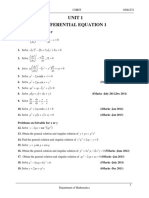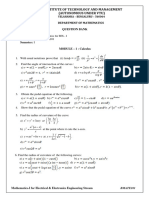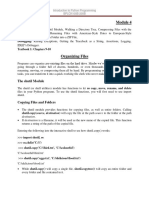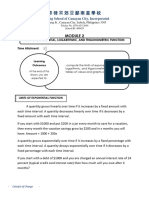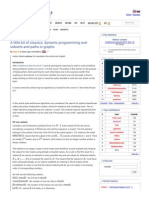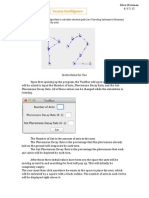BMATE201 – Module 3 – Laplace Transform
3.1 Laplace Transform of elementary functions
Definition:
Let be a real valued function defined for .
Laplace transform of is given by .
Laplace transform of some standard functions:
1. 5.
2. 6.
3. 7.
8.
4.
Proof:
1.
2.
1
�3.
4.
If is a positive integer, And hence
5.
6.
7.
8.
2
�Laplace transform of elementary functions:
1. Find the Laplace transform of
2. Find the Laplace transform of
3. Find the Laplace transform of
4. Find the Laplace transform of
5. Find the Laplace transform of
6. Find the Laplace transform of
3
�7. Find the Laplace transform of
8. Find the Laplace transform of
9. If then find
4
�10. If then find
5
� 3.2 Properties of Laplace Transforms
Property 1: and
1. Find Laplace transform of
2. Find Laplace transform of
3. Find Laplace transform of
4. Find the Laplace transform of
6
� Property 2:
5. Find the Laplace transform of
6. Find the Laplace transform of
7. Find the Laplace transform of
8. Find the Laplace transform of
7
� Property 3:
9. Find the Laplace transform of
10. Find the Laplace transform of
11. Find the Laplace transform of
8
� 12. Find the Laplace transform of
Dr.Narasimhan G, RNSIT 9
� 3.3 Laplace transform of periodic functions
Definition:
A function is said to be periodic if
Example:
Laplace transform of periodic function:
If is a periodic function of period T,
Note:
Problems:
1. Find the Laplace transform of the periodic function defined by
2. If and find
Dr.Narasimhan G, RNSIT 10
� 3. Find the Laplace transform of
4. A periodic function of period is defined by
Find
Dr.Narasimhan G, RNSIT 11
� 5. For a periodic function of period 4 defined by
find
6. If , , Then show that
Proof:
Dr.Narasimhan G, RNSIT 12
� Note:
7. A periodic function of period is defined by
Prove that , where and are constants.
Proof:
Dr.Narasimhan G, RNSIT 13
� 3.4 Laplace transform of unit step function
Introduction:
Unit step function: Unit step function of Heaviside function is given by
Application:
(1) If then
(2) If then
Laplace transform of unit step function:
Important results:
1. Find the Laplace transform of
2. Find the Laplace transform of
3. Find the Laplace transform of
Dr.Narasimhan G, RNSIT 14
�4. Find the Laplace transform of
5. Find the Laplace transform of
6. Express the following in terms of unit step function and hence find the Laplace
transform:
7. Express the following in terms of unit step function and hence find the Laplace
transform:
Dr.Narasimhan G, RNSIT 15
�8. Express the following in terms of unit step function and hence find the Laplace
transform:
9. Express the following in terms of unit step function and hence find the Laplace
transform:
10. Express the following in terms of unit step function and hence find the Laplace
transform:
Dr.Narasimhan G, RNSIT 16
�11. Express the following in terms of unit step function and hence find the Laplace
transform:
sin2 + ]
12. Express the following in terms of unit step function and hence find the Laplace
transform:
Dr.Narasimhan G, RNSIT 17
� 3.6 Solution of Linear Differential Equations
Introduction:
Laplace Transform of the derivatives:
Working rule:
Express the given differential equation using and
Take Laplace transform on both sides.
Apply Laplace transform of the derivatives formula.
Substitute the initial conditions.
Obtain as a function of
Obtain using inverse Laplace transform.
Dr.Narasimhan G, RNSIT 18
� 1. Solve the initial value problem
by using Laplace transforms.
Taking the Laplace transform,
Put
Put
Put
Equating terms,
Taking the inverse Laplace transform,
This is the required solution.
Dr.Narasimhan G, RNSIT 19
� 2. Solve the equation , given that .
Taking the Laplace transform,
Put
Put ,
Equating terms,
Equating terms,
Taking the inverse Laplace transform,
This is the required solution.
Dr.Narasimhan G, RNSIT 20
� 3. Solve the equation , given that .
Taking the Laplace transform,
Put and ,
[By partial fraction]
Taking the inverse Laplace transforms,
This is the required solution.
Dr.Narasimhan G, RNSIT 21
� 4. Solve the IVP , given that by
using Laplace transform.
Taking the Laplace transform,
Put
, By partial fractions
Taking the inverse Laplace transform,
This is the required solution.
Dr.Narasimhan G, RNSIT 22
� 5. Using the Laplace transform method, Solve the initial value problem,
Taking the Laplace transform,
Put
[By partial fractions]
Taking the inverse Laplace transform,
.
This is the required solution.
Dr.Narasimhan G, RNSIT 23
� 6. Solve the equation with , using
Laplace
transform.
Taking the Laplace transform,
Put and ,
, [By partial fractions]
Taking the inverse Laplace transform,
This is the required solution.
Dr.Narasimhan G, RNSIT 24
� 7. Solve the equation given that .
Taking the Laplace transform,
Put
[By partial
fraction
Taking inverse Laplace transform,
This is the required solution.
Dr.Narasimhan G, RNSIT 25
� 8. Solve the IVP, , , using the
Laplace transforms.
Taking Laplace transform,
Put
Taking the inverse Laplace transform,
This is the required solution.
Dr.Narasimhan G, RNSIT 26
� 9. Solve , under the conditions .
Taking the Laplace transform,
Put
------ (1)
Taking and respectively,
These give
Taking the inverse Laplace transform,
This is the required solution.
Dr.Narasimhan G, RNSIT 27
� 10. Solve the initial value problem , with the conditions
.
Taking the Laplace transform,
Put
[By partial fractions]
Taking the inverse Laplace transform,
This is the required solution.
Dr.Narasimhan G, RNSIT 28
� 11. Solve the equation under the conditions
Given equation is
Taking the Laplace transform of the given equation, we obtain
Using the given conditions, this becomes
using the partial
fraction
Taking the inverse Laplace transform of this, we obtain
This is the required solution.
Dr.Narasimhan G, RNSIT 29
� 3.7 Convolution Theorem
If and then .
1. By employing convolution theorem, evaluate
Let
Then
And 1
By convolution theorem,
Therefore,
Dr.Narasimhan G, RNSIT 30
�2. By employing convolution theorem, evaluate
Let
Then
And
By convolution theorem,
Therefore,
Dr.Narasimhan G, RNSIT 31
�3. By employing convolution theorem, evaluate
Let
Then
And
By convolution theorem,
Therefore,
Dr.Narasimhan G, RNSIT 32
�4. By employing convolution theorem, evaluate
Let
Then
And
By convolution theorem,
Therefore,
Dr.Narasimhan G, RNSIT 33
�5. By employing convolution theorem, evaluate
Let
Then
And
By convolution theorem,
Therefore,
Dr.Narasimhan G, RNSIT 34
�6. By employing convolution theorem, evaluate
Let
Then
And
By convolution theorem,
Therefore,
-----------------------------------------------------------------------------
Dr.Narasimhan G, RNSIT 35









